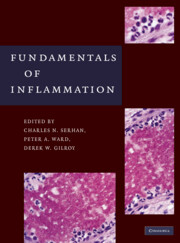Book contents
- Frontmatter
- Contents
- Contributors
- Preface
- PART I THE INFLAMMATORY RESPONSE – AN OVERVIEW
- PART II INDIVIDUAL CELL TYPES
- PART III CHEMICAL MEDIATORS
- PART IV IMMUNOPHARMACOLOGY
- 17 Mediators and Mechanisms of Inflammatory Pain
- 18 Nonsteroidal Anti-Inflammatory Drugs
- 19 Cytokines and Chemokines in Inflammation and Cancer
- PART V INFLAMMATORY DISEASES/HISTOLOGY
- PART VI ANIMAL MODELS OF INFLAMMATION
- Index
- References
18 - Nonsteroidal Anti-Inflammatory Drugs
from PART IV - IMMUNOPHARMACOLOGY
Published online by Cambridge University Press: 05 April 2014
- Frontmatter
- Contents
- Contributors
- Preface
- PART I THE INFLAMMATORY RESPONSE – AN OVERVIEW
- PART II INDIVIDUAL CELL TYPES
- PART III CHEMICAL MEDIATORS
- PART IV IMMUNOPHARMACOLOGY
- 17 Mediators and Mechanisms of Inflammatory Pain
- 18 Nonsteroidal Anti-Inflammatory Drugs
- 19 Cytokines and Chemokines in Inflammation and Cancer
- PART V INFLAMMATORY DISEASES/HISTOLOGY
- PART VI ANIMAL MODELS OF INFLAMMATION
- Index
- References
Summary
INTRODUCTION
Nonsteroidal anti-inflammatory drugs (NSAIDs), sometimes called the “ aspirin-like drugs,” are among the most widely used of all drugs. Aspirin itself was introduced by Bayer in 1898 as a replacement for salicylic acid, which had been available in synthetic form since the 1870s and as the active constituent of plant (e.g., willow bark) preparations for many centuries before that. Since the beginning of the 20th century, the number of NSAIDs has grown substantially: phenylbutazone was introduced in the 1940s, the fenamates in the 1950s, indomethacin in the 1960s, the proprionates in the 1970s, and the oxicams in the 1980s. The 1990s saw a radical new development – the introduction of “ coxibs ” and the new millennium has ushered in an era of reappraisal and reassessment of our understanding of the pharmacology of these drugs and their therapeutic and unwanted effects. There are now more than 50 different NSAIDs on the global market and some of the more prominent examples are listed in Figure 18.1. (Chemical structures of NSAIDs shown, grouped according to chemical structure.)
NSAIDs had been in clinical use for a long time prior to an understanding of their pharmacological mechanism of action. The real breakthrough in NSAID pharmacology was made in the early 1970s when John Vane identified that NSAIDs work by inhibition of prostaglandin (PG)-forming cyclo-oxygenase (COX) activity resulting in the reduction of prostanoid synthesis. The second breakthrough came about in the early 1990s with the discovery of COX-2 that eventually lead to the development of the COX-2-selective NSAIDs that lacked some of the major side effects of classical NSAIDs.
- Type
- Chapter
- Information
- Fundamentals of Inflammation , pp. 234 - 243Publisher: Cambridge University PressPrint publication year: 2010



